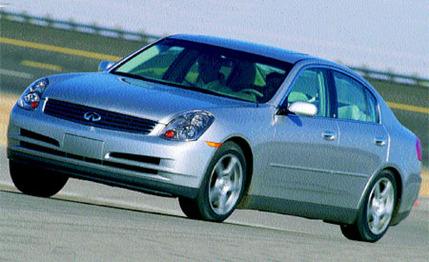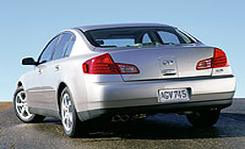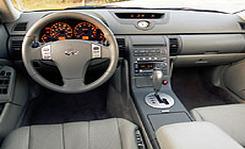
 First Drive Review
First Drive Review
Infiniti swaggered out of Nissan's daydreams and onto our pages in 1989 with a daring luxury concept: big horsepower under the hood, a face so pretty it could just say no to the usual chrome makeup others apply as a "grille statement," and a supple leather interior refreshingly free of "I'm a fancy four-door so I got wood" paneling. We loved the Q45 at first sight.
Then, for the rest of the '90s, Infiniti backpedaled at Olympic speed until its three-model lineup for 2001 was as anonymous as the anycars airbrushed up for insurance advertising. Potential buyers yawned.


So, in the closing minutes of last year, a repentant Infiniti invited a few of the most ardent auto mags to a private showing at which it swore it will never again take its eyes off BMW. It will specialize in powerful, rear-drive machines that will bring boundless joy to drivers. We yawned; another distressed automaker was taking the Bimmer pledge. Then we were turned loose in preproduction samples of a new 3-series combatant called the G35, promised for stores near you in March.
Oh! These guys are serious. The G35 is a radical reach into Nissan's Le Mans experience for tire-loading and airflow concepts that could be baked into a roadgoing sports sedan. The G35's unusual proportions are a direct result. This is a long-wheelbase design, 112.2 inches, almost five inches longer than the target 3-series. The front wheels are pushed forward--slightly ahead of the engine's center of gravity, thereby easing front weight to just 52 percent--and the rear wheels are pulled back out of rear-seat territory. Placing the wheels at the far corners of the body makes a roomy space inside, and it also reduces the change in tire loading for any given maneuver, which should make handling more forgiving.


This is a long car for the Bimmer class, stretching out to 186.2 inches overall, roughly 10 inches longer than the 3-series and the Lexus IS300, seven more than the Audi A4. The extra length allows smoother body lines for airflow management and, at the same time, much more passenger space. The G35 encloses 101 cubic feet of interior volume, 10 percent more than the 3-series and its followers. Trunk space is significantly larger, too.
Airflow was clearly a priority. The long hood ramps down in front. The windshield angle is steep for this class. Underneath, the shapes really get interesting. A belly pan starts at the nose and continues back just past the engine, creating a zone of high-speed airflow at the front wheels. After an expansion chamber under the front seat, the flat-bottom fuel tank under the rear seat and a specially shaped muffler under the prop shaft work together to resume the flat-pan effect, speeding up airflow as it passes under the rear suspension before exhausting to a diffuser section under the trunk.
The result? Drag coefficient is just 0.27--very good for a small car--with zero lift in front. An optional Aero package brings a wing and a pair of plastic fairings under the floor to ease flow around the rear suspension and tires, lowering drag to 0.26 and total lift to zero.
The G35 has no powertrain options. A 3.5-liter all-alloy V-6 with variable timing on the intake cams is standard. Output is 260 lusty horses. Counting up, that's 35 more than in the 330i, for a sedan that weighs less than 50 more pounds on Infiniti's scale. A five-speed automatic with a slick manumatic shifter is the transmission, with an optional six-speed manual promised for late in the year.
The suspension is unusual in this class. No struts. Instead, multilink at all corners, with many alloy links and an aluminum rear crossmember to save weight. Also, there are big hollow anti-roll bars at both ends. Compared with struts, this approach enables better management of camber and steer angles, and the coils can be located farther outboard where they intrude less into spaces that might be better used for, say, trunk space, to name one.